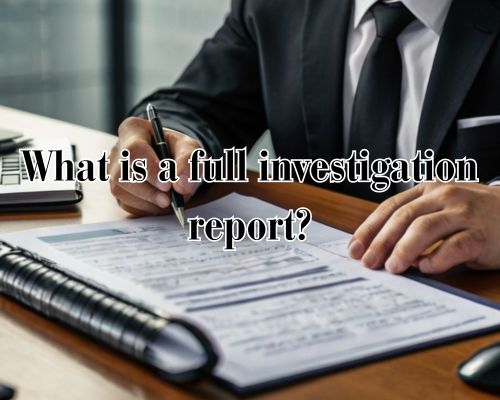“A full investigation report is a detailed document that sets out the findings of an investigation. It could involve workplace incidents, criminal activities, or other inquiries. This report serves to establish a factual record of the events. It compiles evidence and observations to draw clear conclusions.” said Charles Jimerson of Private Investigator West Palm.

Your investigation report typically includes the purpose of the investigation, the method used, and the scope covered during the inquiry. By presenting information in a clear and concise manner, you enable decision-makers to fully understand the context and outcomes of the investigation.
Readers will find that, by following structured and precise reporting practices, such documents play a crucial role in ensuring transparency and accountability.
Composition of an Investigation Report
A well-structured investigation report provides a comprehensive account of an inquiry. It details findings, evidence, and conclusions with clarity and precision. Each section plays a pivotal role in ensuring the documentation is thorough and credible. Let us have clear understanding on this with Private Investigator West Palm.
Executive Summary
The Executive Summary offers a brief overview of the investigation. It should outline key findings, conclusions, and recommendations succinctly. This section is essential for readers who need a quick understanding of the report without delving into the detailed content. It provides a snapshot of the major points, helping stakeholders grasp the essence of the investigation’s results and the recommended actions.
Preliminary Case Information
The Preliminary Case Information includes basic details about the case. This involves recording the date, location, and nature of the incident, as well as the identities of the individuals involved. Additionally, context about the circumstances leading to the investigation should be documented. This section sets the stage, ensuring readers understand the background and scope of the investigation right from the start.
Detailed Findings
The Detailed Findings section delves into the heart of the investigation. Every key finding should be presented with supporting evidence, such as interviews, documents, and other relevant data. This section must clearly articulate the root causes and implications of each finding.
Ensure that all findings are thoroughly substantiated to maintain credibility. Avoid long-winded explanations and focus on delivering information in a clear, concise, and structured manner.
Conclusions and Recommendations
Conclusions and Recommendations encapsulate the outcomes of the investigation and propose actionable steps. This section should summarize the investigation’s results, stating whether the allegations were substantiated or unsubstantiated.
From these conclusions, develop recommendations aimed at addressing the issues identified, preventing future incidents, and improving overall processes. Chain them logically to the findings, ensuring they are feasible and well-grounded in the investigation’s findings.
Crafting an Effective Investigation Report
A well-crafted investigation report is clear, logically structured, and effectively communicates findings. It relies on accurate interviews, thorough assessment of evidence, and precise language.
Interviews and Statements
Conduct interviews systematically, ensuring you cover all relevant parties. Focus on collecting detailed witness statements and documenting them accurately.
Start with basic information: names, roles, and contact details. Record the date, time, and location of each interview. Use open-ended questions to encourage comprehensive responses.
Verify facts by cross-referencing statements. Accurate, verbatim quotes help maintain the integrity of the information gathered.
A structured interview process strengthens the credibility and reliability of the investigation report.
Assessment of Evidence
Assess evidence meticulously, evaluating its relevance and reliability. Gather all pertinent documents, physical evidence, and digital data. Create an evidence log detailing each item’s source, type, and chain of custody.
Compare and contrast evidence with witness statements to identify consistencies or discrepancies. Highlight key evidence that supports or contradicts claims.
Organize evidence in a logical sequence to aid understanding. Proper assessment substantiates findings and conclusions, bolstering the report’s credibility.
Language and Presentation
Use clear, simple language to communicate findings. Avoid jargon and technical terms unfamiliar to the reader. Write in an active voice, specifying actions and agents clearly.
Structure the report into sections with headings and subheadings for easy navigation. Use bullet points and tables where appropriate to present data concisely.
Maintain a neutral, objective tone. Be precise, ensuring statements are fact-based and free from bias. The report’s presentation should facilitate understanding and provide a logical flow of information.